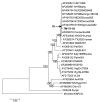Genome sequence and attenuating mutations in West Nile virus isolate from Mexico
- PMID: 15663867
- PMCID: PMC3323401
- DOI: 10.3201/eid1012.040647
Genome sequence and attenuating mutations in West Nile virus isolate from Mexico
Abstract
The complete genome sequence of a Mexican West Nile virus isolate, TM171-03, included 46 nucleotide (0.42%) and 4 amino acid (0.11%) differences from the NY99 prototype. Mouse virulence differences between plaque-purified variants of TM171-03 with mutations at the E protein glycosylation motif suggest the emergence of an attenuating mutation.
Figures


References
Publication types
MeSH terms
Grants and funding
LinkOut - more resources
Full Text Sources
Other Literature Sources
Molecular Biology Databases
